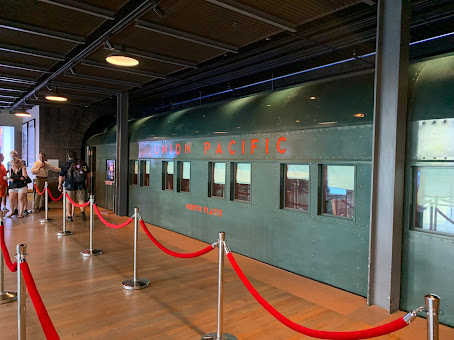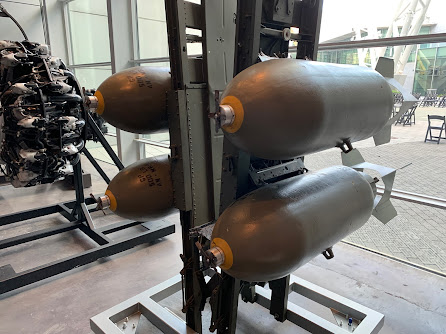Back to New Orleans for another excursion - the National World War II Museum.
After the museum opened, it was later designated by U.S. Congress as America's official National WWII Museum in 2004. It is a Smithsonian affiliated museum.
After buying our tickets, we were directed to the Union Pacific train. This is a stationery train modeled after the Pullman sleeper cars of the 1940s, allowing guests to experience the sights, sounds, and emotions of going off to war.
Once we entered, we viewed videos showing vintage photos, historic headlines and film footage depicting the Axis' rise to power and threat to democracy, all while listening to Big Band and 1940s music. Really got us in "the mood".
I got Bob Hope! Bob performed his first USO show on May 6, 1941, at March Field, California. Note: My grandfather was stationed there during WWI. Bob continued to travel and entertain troops for the rest of World War II, the Korean War, Vietnam War, third phase of the Lebanon Civil War, the later years of the Iran-Iraq War, and the 1990-1991 Persian Gulf War. His USO career lasted a half-century during which he headlined 57 times.
There were some very interesting items on display.
This is a portion of the internal bomb rack from a B-17. The internal racks were equipped with 42 bomb stations and were capable of carrying bombs ranging in weight from 100 to 2,000 pounds. The B-17 also had two external bomb racks that allowed the plane to carry the 4,000 pound "Block Buster" bomb. As the name implies, the 4,000 pounder could destroy a city block.
This wool "Ike jacket" has corporal chevron patches on the left sleeve, and the Red Ball Express insignia on the right sleeve. On the right chest is a "ruptured duck" discharge patch, which indicates an honorable discharge.
The "Normandy Liberty Bell", a 2009 gift from the Normandy region of France to the National World War II Museum as an expression of its gratitude toward its liberators of 1944, is the only exact, ringing replica of Philadelphia's original Liberty Bell.
This iconic semi-automatic P08 was Imperial Germany's standard pistol during World War I. Produced until 1944, it was a favorite among German troops and a highly-prized war trophy for American GIs.
The Sherman tank's primary role was infantry support, spearheading attacks as well as bolstering defensive positions. Though frequently outgunned by their German counterparts, Shermans proved easier to maintain - often fixed on the battlefield. This particular tank, a rare M4A39 model (only a few hundred were built), carries applique armor for additional protection, a common feature.
"My Gal Sal" was part of one of the first ferry flights to England in June, 1942. She crash landed on a Greenland icecap due to severe weather. The entire crew survived the 10 day ordeal to fight another day. "My Gal Sal" is among the first of thousands of B-17s that attempted to fly the treacherous northern air route to get into the fight that culminated in America's industrial might blocking out the skies above Nazi Germany.
We learned an interesting fact about Tootsie Rolls.
We spent some time in the interactive exhibits including Road to Tokyo, Road to Berlin, The D-Day Invasion of Normandy, and the U.S. Merchant Marine Gallery. Each exhibit is tailored to reflect the environment of the specific area or function of the subject matter.
A lot of our attention was paid to the Road to Tokyo as Ron's dad spent his time in the Pacific on the Marshall Islands, specifically Kwajelein. Unfortunately, his official military records were destroyed in the National Personnel Records Center fire of 1973, which occurred in the St. Louis suburb of Overland, Missouri from July 12-16, 1973. The fire destroyed 16 to 18 million official military personnel records. While he didn't speak of his time there often, he did relate that he spent several years on the island with one of his duties to bury the dead Japanese after the air raids.
We were running on empty so we called it a day and went outside to admire this sculpture created by Major Fredric Arnold (Ret.) and completed in 2016 when he was 94 years old.
The sculpture depicts twelve fighter pilots during a mission briefing. The lighter colored spirits of aviators already killed in action look over the shoulders of those still alive. All were destined to die.
Major Arnold wrote: Of fourteen original members of my original group of Class 42-J P-38 fighter pilots, only two survived six months of combat: Jim Hagenback and me. Much of our survival was due to luck. Years later, we vowed to each other that whoever was left standing would do something to honor the twelve. Lest We Forget: The Mission stemmed from our deep gratitude to the twelve original members of our group that didn't survive to live their lives in peace....
Although the sculpture began as a testament to the twelve pilots in my squadron, the scope of the work has grown. Now the twelve individual figures are dedicated to the memory of the more than 88,000 U.S. aviators who gave their lives during WWII. I am honored that three former Chairmen of the Joint Chiefs of Staff and a former Senator have endorsed the deep meaning of my sculpture.
Major Fredric Arnold (Ret.) was 96 when he died on Memorial Day 2018, after completing the most ambitious and meaningful work of his life.
What an emotional day. Thank you to all who fought in World War II, but most importantly to our fathers Gordon F. Levy and Herman P. Ast (later Austen).























Sounds like a fascinating museum.
ReplyDeleteIt is very well done and particularly interesting since both of our fathers served in WW II.
Delete